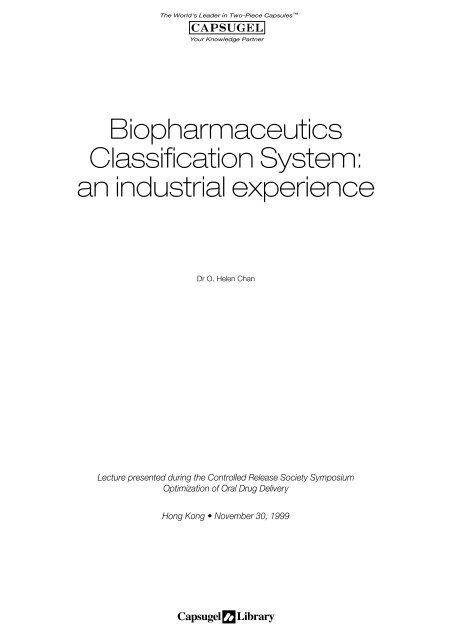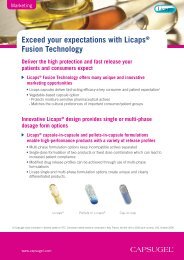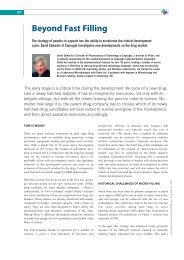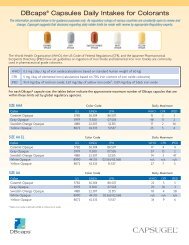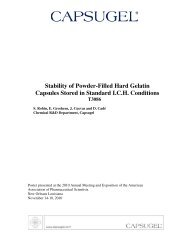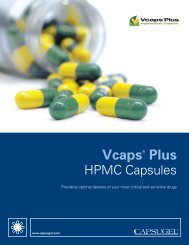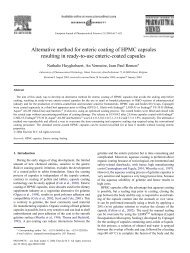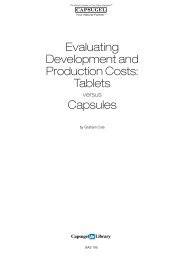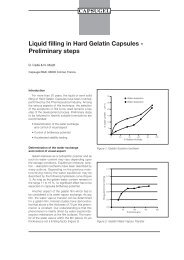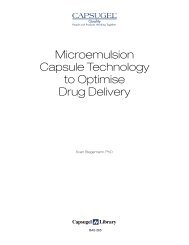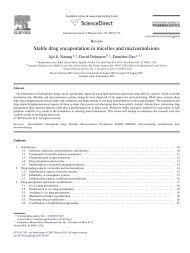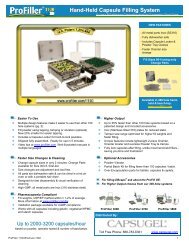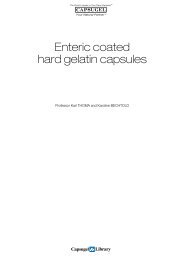Biopharmaceutics Classification System: an industrial ... - Capsugel
Biopharmaceutics Classification System: an industrial ... - Capsugel
Biopharmaceutics Classification System: an industrial ... - Capsugel
- No tags were found...
Create successful ePaper yourself
Turn your PDF publications into a flip-book with our unique Google optimized e-Paper software.
<strong>Biopharmaceutics</strong><strong>Classification</strong> <strong>System</strong>:<strong>an</strong> <strong>industrial</strong> experienceDr O. Helen Ch<strong>an</strong>Lecture presented during the Controlled Release Society SymposiumOptimization of Oral Drug DeliveryHong Kong • November 30, 1999
<strong>Biopharmaceutics</strong> <strong>Classification</strong> <strong>System</strong>:<strong>an</strong> <strong>industrial</strong> experienceDr O. Helen Ch<strong>an</strong>Parke-Davis Pharmaceutical Research, Ann Arbor, Michig<strong>an</strong>, USAJoseph R. Robinson, University of Wisconsin,USA: We'd like to turn now to the next presentation,the <strong>Biopharmaceutics</strong> <strong>Classification</strong> <strong>System</strong>:<strong>an</strong> <strong>industrial</strong> experience by O.H. Ch<strong>an</strong> <strong>an</strong>d H. Bockbrader,of Parke-Davis. The speaker will be DrCh<strong>an</strong>.Dr O. Helen Ch<strong>an</strong>, Parke-Davis, Ann Arbor,USA: Th<strong>an</strong>k you for your introduction, Dr Robinson.I would like to th<strong>an</strong>k Dr Vince Lee <strong>an</strong>d the org<strong>an</strong>izingcommittee for inviting me to speak here at myPotential Barriers to Oral Bioavailability• Dissolution/ Precipitation• Hydrolysis (Acid Hydrolysis,Enzymic Hydrolysis)Rowl<strong>an</strong>d <strong>an</strong>d Tozer, 1978GutLumenTo FecesFigure 1.Gut WallMetabolismPortalVein• Intestinal permeability• Metabolism in Gut Wall• Hepatic First-PassBloodFlowLiverMetabolismTo <strong>System</strong>icCirculationbirthplace, Hong Kong. The title of my talk is,<strong>Biopharmaceutics</strong> <strong>Classification</strong> <strong>System</strong>: <strong>an</strong> <strong>industrial</strong>experience.I would like to acknowledge my colleagues,Dr Howard Bockbrader who provided me with themajority of the data, <strong>an</strong>d Dr Jack Cook for hiscontribution to the discussion.Figure 1 must be familiar to m<strong>an</strong>y of you. Itshows the potential barriers for solid oral dosageforms. The barriers that the dosage form has toovercome before it c<strong>an</strong> reach the systemic circulationinvolve dissolution or precipitation in the GI(gastrointestinal) lumen, instability in the GI tract,<strong>an</strong>d permeation through the gut wall. And after thatthere is a first pass at the liver. If the compounditself is stable in the GI environment – in the lumenor in the gut wall – intestinal absorption is affectedmainly by dissolution, solubility or permeation.The c<strong>an</strong>didates for biowaiver based on BCS arecompounds that fulfil five qualifications. They haveto be immediate-release solid oral dosage forms.They c<strong>an</strong>not be drugs with a narrow therapeuticindex. The formulation has to dissolve rapidly, <strong>an</strong>dthe compound itself has to have high solubility <strong>an</strong>dhigh permeability.Figure 2 is one that I borrowed from Ajaz Hussainof the Food <strong>an</strong>d Drug Administration (FDA). Itexplains the rationale for Class I compounds thatmay qualify for a biowaiver: when the dissolutionrate is much greater th<strong>an</strong> the gastric emptying,dissolution is not likely to be rate-limiting.3
Jejunal Permeability Peff (x10 -4) cm/secBCS Class Membership10LikelyWhen dissolutionrate > gastric emptyingdissolution not likelyto be rate determining10.1Rapid DissolutionIIIIUnlikely0.011 10 100 1000 10000 100000Volume (ml) of water required to dissolve the highest dosestrength at the lowest solubility on the pH 1-8 r<strong>an</strong>geJejunal Permeability Peff (x10 -4) cm/secSame as above,however, need toestablish why absorptionis incomplete -sensitiveto certain excipients?Figure 2.Today I am going to show you two case studies.The first concerns a compound that we believebelongs to Class I, <strong>an</strong>d where we think that we maybe able to get a biowaiver; at least, we're formallygoing to request for one. I'll also present to you<strong>an</strong>other case study, on a Class III compound, wherewe actually obtained a biowaiver before there was aBCS draft guid<strong>an</strong>ce.BCS Class Membership1010.1VerapamilPropr<strong>an</strong>ololMetoprololR<strong>an</strong>itidineCimetidineAtenololIIIIIIDissolution likelyto be “rate determining”IVIVC possible (<strong>an</strong>d wouldneed to be demonstrated)IVGenerally “problem”drugs in vitro dissolutionmay not be reliableIVIVC may be possibleKetoprofenNaproxenCarbamezapineHydrochlorothiazideFurosemideIIIVPregabalinFigure 4.NH 2COOH• MW 159• hydrophobicitypH log P1.0 -1.904.0 -1.437.4 -1.35• pKa 4.0, NAWe accept, of course, that c<strong>an</strong>didates for thebiowaiver be in immediate-release dosage form. Butwe believe that it is reasonable to include in thebiowaiver controlled-release or modified-releasedosage forms where one c<strong>an</strong> demonstrate IV/IVC(in-vitro/in-vivo correlation).Figure 3 shows several examples of compoundsthat belong to each class. I would like to draw yourattention to metoprolol, which is a high-permeability/high-solubilitycompound that the FDA suggestsas a potential internal st<strong>an</strong>dard, <strong>an</strong>d which we diduse in one of our case studies.Figure 4 is our first case-study example, pregabalin.Pregabalin is being developed as <strong>an</strong> <strong>an</strong>algesic,<strong>an</strong>ti-convuls<strong>an</strong>t, <strong>an</strong>d <strong>an</strong>xiolytic. It is a smallpolar molecule, with a molecular weight of about160, <strong>an</strong>d the log P is negative at all physiological pHlevels. It has two ionizable groups, the pKa of thecarboxylic acid is about 4.0 but the one for thesolubility (mg/mL)Pregabalin solubility10010300 mg250 mL0.011 10 100 1000 10000 100000Volume (ml) of water required to dissolve the highest dosestrength at the lowest solubility on the pH 1-8 r<strong>an</strong>ge10.1 NHCIAcetatebufferpH 4.0WaterPhosphatebufferpH 7.40.1 NNaOHFigure 3.Figure 5.4
in situ Rat Intestinal Perfusionmale Wistar ratjejunal segments (length= 10 cm)perfusion flow rate = 0.1 ml/minwater tr<strong>an</strong>sport: 14C-PEG 4000 measurementInfusion SyringePump <strong>System</strong>Figure 6.DrugSolutionSampleCollectionamine is not determined, although I think it's about11. It is <strong>an</strong> isobutyl GABA in structure, i.e. gammaaminobutyric acid.We determined all solubilities at equilibrium(Figure 5). For pregabalin, it is pH-dependent, goingfrom 0.1 normal hydrochloric acid (HCl) to 0.1normal sodium hydroxide, with the solubility beinglowest in water <strong>an</strong>d the phosphate buffer, pH 7.4.At all pH levels, the solubility is much higher th<strong>an</strong>the highest-dose strength divided by 250 ml, whichis the guid<strong>an</strong>ce requirement. So it is a high-solubilitycompound. Note that this was a log scale.Figure 6 indicates the model we used to determinepermeability. It is <strong>an</strong> in-situ rat intestinal perfusionmodel where we perfused the compound atthe proximal end <strong>an</strong>d measured what came outPregabalin Permeabilitypermeability x 10 6 (cm/s)50403020100Figure 7.pregabalinmetoprololfrom the distal end. As long as the compound isstable in the GI tract, what is not coming out fromthe distal end at steady-state c<strong>an</strong> be safely assumedto be absorbed. Besides perfusing the drug,we also perfused the internal st<strong>an</strong>dard, metoprolol,as well as a water tr<strong>an</strong>sport marker, simult<strong>an</strong>eously.Figure 7 shows the research results for pregabalin.The permeability of pregabalin is pretty high; it isfairly comparable to the permeability of metoprolol,the high-permeability internal st<strong>an</strong>dard that weused. So from this Figure we c<strong>an</strong> tell that pregabalinis a high-permeability compound.We also examined the relationship betweenpermeability <strong>an</strong>d the fraction absorbed in hum<strong>an</strong>s(Figure 8). The fractions absorption of the referencecompounds are either from the literature, or weredetermined experimentally by our comp<strong>an</strong>y. Withthe value of permeability that pregabalin has, it ispredicted to be about 90 percent absorbed inhum<strong>an</strong>s.The solid curve on the Figure is the correlationfor the rat intestinal perfusion model. AlthoughI have not presented the Caco-2 data here today,the correlation curve is the dotted line shown on theFigure.When we determined the bioavailability inhum<strong>an</strong>s, the oral bioavailability was 90 percent,Fraction Absorbed in Hum<strong>an</strong>vs. PermeabilityFraction Absorbed (hum<strong>an</strong>s)1201008060HydrocortisonePregabalinGabapentin0.04 mMPhenytoinAcetaminophenL-Phe40Gabapentin50 mMPerfusionCaco-220Simulated PerfusionSimulated Caco-2M<strong>an</strong>nitol00 20 40 60 80 100 120 140 160 180 200Permeability x 10 6 (cm/s)Figure 8.5
Gabapentin Stability4 weeks at ambient temp % degradation at 60°Csolvent % degradation solvent 15 min 30 min 120 minwater 0 water < 0.2 < 0.4 < 0.4buffer pH 1 < 2buffer pH 4 < 1 buffer pH 4 < 0.2 < 0.4 < 0.4buffer pH 7 0 buffer pH 7 < 0.4 < 0.4 < 0.6buffer pH 10 ~15 buffer pH 10 < 0.5 < 2 ~ 6Figure 11.this point. Post conference notes. The guid<strong>an</strong>cebecame official August 2000.The next example we have is gabapentin. Gabapentinis also a small polar molecule, just likepregabalin, <strong>an</strong>d it has the same GABA structure,with a cyclohexyl ring. It has two ionizable groups,with a pKa of about 3.7 <strong>an</strong>d 10.7 respectively.Figure 11 shows the stability of gabapentin. Wefound that at ambient temperature for four weeks,gabapentin was stable in water or in a buffer withpH r<strong>an</strong>ge of 1-7, but not at pH 10. At the extremecondition of 60° Celsius, we found that gabapentinwas stable in buffer 4 <strong>an</strong>d 7 for up to two hours, butnot so stable in pH 10.The solubility of gabapentin in 0.1 normal HCl,water <strong>an</strong>d 0.1 normal sodium hydroxide is pH-independent(Figure 12). At all pH levels, we found thatthe solubility was much higher th<strong>an</strong> the highestdose strength, 800 mg, divided by 250 ml. So thisis a high-solubility compound.Gabapentin Solubility1000Using the same in situ rat intestinal perfusionmodel (Figure 6), we found that the permeability ofgabapentin was concentration-dependent. At thehigher concentration of 50 millimolar, permeabilitywas a lot lower th<strong>an</strong> at the low concentration of0.01 millimolar (Figure 13). At either of theseconcentrations, we also found that the permeabilitywas lower th<strong>an</strong> the internal st<strong>an</strong>dard, prednisolone,which is more th<strong>an</strong> 90 percent absorbed. So gabapentinpermeability is concentration-dependent,<strong>an</strong>d it is a low-permeability compound.The correlation curve in Figure 8 show that gabapentin,at 0.04 millimolar, is predicted to be about70 percent absorbed in hum<strong>an</strong>s, <strong>an</strong>d at the higherconcentration, 50 millimolar, about 35 percentabsorbed. So, at either concentration, it is a lowpermeabilitycompound.Figure 14 represents data from in-vivo studies inhum<strong>an</strong>s. Single-dose findings are indicated by thediamond shape, <strong>an</strong>d agree with the predictions,Gabapentin Permeability3530solubility (mg/mL)10010800 mg250 mLpermeability x 10 6 (cm/s)25201510510.1 NHCIWater0.1 NNaOH00.01 mMgabapentin50 mMgabapentinprednisolone(reference)Figure 12.Figure 13.7
Gabapentin absorptionFraction Absorbed10090807060504030201000 1000Figure 14.single-dosemultiple dosemultiple dose2000 3000 4000 5000 6000Dose (mg)with approximately 70 percent absorbed at a lowdose <strong>an</strong>d about 35 percent at the higher dose. Thecircles <strong>an</strong>d the tri<strong>an</strong>gles are what result from themultiple doses. With both the single-dose studies<strong>an</strong>d the multiple-dose studies, there is a dosedependentabsorption.Figure 15 shows the dissolution methods usedfor gabapentin, with the same apparatus as for pregabalin.We have two types of formulations, capsules<strong>an</strong>d tablets.Gabapentin Dissolution• USP Apparatus II, 50 rpm, 900 mL• Dissolution is pH independentcapsulestabletswaterwater0.06 N HCl 0.06 N HClphosphate buffer pH 7.5 acetate buffer pH 4.5phosphate buffer pH 6.8Figure 15.We found that the capsules from Freiburg dissolvedvery rapidly, more th<strong>an</strong> 80 percent in 10 minutes;we had only one time-point for the 300-mg<strong>an</strong>d the 400-mg capsules From Vega baja (Figure16). All three of these capsules were fairly rapidlydissolved, about 90 percent in 20 minutes. Thethree types of tablets -- the 600-mg tablet from eitherMorris Plains or Vega Baja, or the 800-mg tabletfrom Morris Plains -- did not dissolve as rapidlyGabapentin Dissolution% dissolved120100806040200010 20 30 40 50Time (min)* Specifications: capsules ≥ 80% in 20 min.; tablets ≥ 75% in 45 min.Figure 16.300-mg capsule (Freiburg)300-mg capsule (Vega baja)400-mg capsule (Vega baja)600-mg tablet (Morris Plains)600-mg tablet (Vega baja)800-mg tablet (Morris Plains)as the capsules, although they still dissolved veryrapidly as defined by the guid<strong>an</strong>ce, about 85percent at 30 minutes.Figure 17 is a summary of some of the bioequivalencestudies carried out on gabapentin. The100-mg capsules <strong>an</strong>d the 300- <strong>an</strong>d 400-mg capsulesare all bioequivalent to the same-strengthsolution. The tablets from Morris Plains were bioequivalentto the capsules <strong>an</strong>d the 600-mg tabletsfrom Baja were also bioequivalent to two 300-mgcapsules. What we were requesting was a biowaiverfor the 800-mg tablet.I mentioned earlier that the tablets did notdissolve as rapidly as the capsules, although bothstill dissolve rapidly as defined by the guid<strong>an</strong>ce.What I'm going to show is that dissolution rate doesnot matter very much for this compound. Figure 18is a simulation. The circles represent the actual datafor the 800-mg tablet, the broken lines are the varioussimulations. Clearly, the compound is completelydissolved, regardless of whether the dissolutionrate is 50 percent, 25 or 17 percent.Figure 19 gives the concentration-time profile inhum<strong>an</strong>s. The circles are the actual observed datafor the tablet. The dotted line is not very clear, but itrepresents the 50 percent dissolution rate. If thedissolution rate is only 50 percent of the original, orif it is 25 percent (as shown by the line with shortdashes), you c<strong>an</strong> see that in either case the8
Gabapentin BioequivalenceFormulation Reference Bioequivalent4x100-mg capsule 400-mg solution Yes300-mg capsule (Vega Baja) 300-mg solution Yes400-mg capsule (Vega Baja) 400-mg solution Yes600-mg tablet (Morris Plains) 2x300-mg solution Yes800-mg tablet (Morris Plains) 2x400-mg solution Yes600-mg tablet (Vega Baja) 2x300-mg solution Yes800-mg tablet (Vega Baja) 2x400-mg solution biowaiverFigure 17.Simulation - Dissolution800Simulation - Pharmacokinetics5Observed DataAmount Dissolved (mg)600400200Observed 800-mg tabletDissolution Rate PredictedDissolution Rate = 50%Dissolution Rate = 25%Dissolution Rate = 17%gabapentin plasma conc (µg/mL)4321Predicted based on Dissolution ProfileDissolution Rate = 50% of TabletDissolution Rate = 25% of TabletDissolution Rate = 17% of Tablet000.4 0.8 1.2 1.6 2.0 2.4 2.8 3.2 3.6 4.0Time (hr)0010 20 30 40 50 60Time (hr)Figure 18.Figure 19.concentration-time profile does not ch<strong>an</strong>ge verymuch. When the dissolution rate is only 17 percentof the original, as shown by the line with longdashes, that's when the concentration-time profiledemonstrably ch<strong>an</strong>ges. So what we c<strong>an</strong> concludeis that if the dissolution rate of the product isbetween one-quarter to one-half of the originaldissolution rate, the concentration/time profile isonly minimally affected.With gabapentin we also know that the concentrationdependence is probably due to a carriermediatedtr<strong>an</strong>sport that's saturable, <strong>an</strong>d the carrieris a system L large neutral amino acid tr<strong>an</strong>sporter.In the case of gabapentin, since it is a highlysolublecompound with low permeability <strong>an</strong>ddissolves rapidly, the rate-limiting step is thepermeability, not dissolution.Gabapentin Biowaiver• If 800-mg tablet (Vega Baja) achieved dissolutionspecification of ≥ 75% in 45 min➡ expect bioequivalence• Biowaiver gr<strong>an</strong>ted• BCS biowaivers could be safely extendedto Class III compoundsFigure 20.So when we asked for the biowaiver, our thinkingwas that if the 800-mg tablet could achieve the dissolutionspecification, we should expect bioequivalence(Figure 20). In fact, we were gr<strong>an</strong>ted a biowaiver, <strong>an</strong>dthis was before the BCS draft guid<strong>an</strong>ce was published.We also conclude that even though the guid<strong>an</strong>ceon biowaivers only allows for Class I compounds,9
we think that this is a good case for demonstratingit c<strong>an</strong> be safely extended to Class III compounds,because the compound is not dissolution-rate limited,it is permeability-limited.In summary, what I have presented to you aretwo case studies. Pregabalin is a Class I compoundwhere we think we have a good case for obtaining abiowaiver. The second example, gabapentin, is aClass III compound, which is not a class that is currentlyprovided for by the guid<strong>an</strong>ce for biowaivers –<strong>an</strong>d yet we indeed obtained a biowaiver. Th<strong>an</strong>k you.Rol<strong>an</strong>d Daumesnil, <strong>Capsugel</strong> AG, Switzerl<strong>an</strong>d:Now for some questions – but before westart, let me just say to my colleague, she's talkingabout Warner-Lambert's two most import<strong>an</strong>tproducts for the next few years. We are expectingboth of them to be blockbusters.Professor Gordon Amidon, University of Michig<strong>an</strong>,USA: They ch<strong>an</strong>ged them from capsule totablet, though, Rol<strong>an</strong>d, so... Helen, one point, firstI would just clarify the term 'biowaiver'. You are waivingin-vivo bioequivalence. I think saying 'waivingbioequivalence' is d<strong>an</strong>gerous. We're being moreprecise in the l<strong>an</strong>guage.Dr O. Helen Ch<strong>an</strong>, Parke-Davis, Ann Arbor,USA: Yes, it's waiving the in-vivo bioequivalencestudies. Th<strong>an</strong>k you for your correction.Professor Gordon Amidon, University of Michig<strong>an</strong>,USA: The guid<strong>an</strong>ce was published inJ<strong>an</strong>uary 1999, the draft form was available in the fallof 1996, so it took that long to get it through theFDA, almost three years. I think your example's abrilli<strong>an</strong>t one with gabapentin, low permeability/highsolubility -- as long as the dissolution is fastenough, <strong>an</strong>d it clearly is. You're saying 30 minutesis good enough <strong>an</strong>d I think we believe that, but weneed data to show it. I think the concern is we'recertain that if you slowed it down further, at somepoint you would have a problem.Dr O. Helen Ch<strong>an</strong>, Parke-Davis, Ann Arbor,USA: Yes, if you slow it down further it is not justpermeability-limited, it is also dissolution-limited.I agree.Rol<strong>an</strong>d Daumesnil, <strong>Capsugel</strong> AG, Switzerl<strong>an</strong>d:Another question please? Tom.Tom: Could you comment a little bit on the differencebetween the Caco-2 model <strong>an</strong>d the in-situperfusion model you used for permeability studies?Dr O. Helen Ch<strong>an</strong>, Parke-Davis, Ann Arbor,USA: Yes. The question is the difference betweenCaco-2 <strong>an</strong>d the in-situ perfusion model. For m<strong>an</strong>ycompounds, I believe that if you achieve the correlationcurves that I showed you (Figure 8), you c<strong>an</strong>use either model.But what we have found in practice is that withsome compounds -- for example, pregabalin orgabapentin – somehow, Caco-2 has a lower permeabilityth<strong>an</strong> in-situ perfusion <strong>an</strong>d, comparing thatpermeability to the reference compound, you wouldassume that it is a low-permeability compound. Infact, it may not be.So what I'm saying is that the Caco-2 model c<strong>an</strong>give you a false-negative <strong>an</strong>d sometimes we knowwhy – sometimes it's because of the expression ofthe tr<strong>an</strong>sporter – but sometimes we do not knowwhy, yet. Also, to use it for the guid<strong>an</strong>ce purpose,since the Caco-2 is <strong>an</strong> in-vitro model you have todemonstrate that it is not a carrier-mediated tr<strong>an</strong>sportcompound, because you don't know whetherthe expression is comparable to in-vivo or not. SoI would say the rat perfusion model is a safe bet.Professor Gordon Amidon, University of Michig<strong>an</strong>,USA: Just a quick comment about theCaco-2 cells. I think the FDA will allow Caco-2 cellsbut you have to use, like, 20 st<strong>an</strong>dard compounds,you really have to characterize your system withreference compounds. But at least in principle theywill allow Caco-2 cell data to be used in the assessmentof high <strong>an</strong>d low permeability.Dr O. Helen Ch<strong>an</strong>, Parke-Davis, Ann Arbor,USA: Yes. Actually, with either Caco-2 or the perfusionmodel, you have to have 20 reference compounds.Professor Gordon Amidon, University of Michig<strong>an</strong>,USA: The in-vivo system is probably moreaccurate overall, but…Joseph R. Robinson, University of Wisconsin,USA: Th<strong>an</strong>k you, Gordon, th<strong>an</strong>k you verymuch, Dr Ch<strong>an</strong>. We are now at coffee break time.I w<strong>an</strong>t to th<strong>an</strong>k all three speakers in this morning'spresentation. Please be prompt <strong>an</strong>d reassemble at10.30 for the next half of this morning's session.Th<strong>an</strong>k you.10BAS 216 -b- E 200 1


